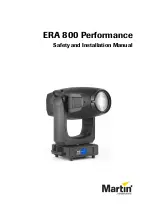
Chapter 1: Safety Considerations
1-4
RF Warning
The LPI1010 has been tested for both radiated and conducted RF interference and for immunity to RF fields, and
has been found to be in compliance with FCC Part 18 and EU Council Directive 2014/30/EU, the EMC Directive
EN 61326:2013—
Electrical equipment for measurement, control, and laboratory use—EMC Requirements.
Testing
was performed in accordance with the Basic Immunity Requirements contained in Table 1 and the Emission
Requirements contained in Section 7.
However, your LPI1010 system still does generate some radio-frequency energy. The radiated levels are low
enough that the LPI1010 should not create an interference problem in most industrial laboratory environments.
Your LPI1010 system may also respond to environmental radio-frequency energy. We recommend you avoid using
mobile phones and other radio-frequency equipment in the same room as an LPI1010. The LPI1010 circuitry has
been tested for operation in high-intensity RF fields and has demonstrated little response to those fields. However,
there is no guarantee that the electrochemical cell and its connections will not respond to RF fields. This response
most often appears as DC shifts in a cell’s response caused by rectification of the RF signal.
A Faraday cage surrounding your cell may be used to minimize the effect of environmental RF fields. If your cell is
isolated from earth ground, Gamry recommends connecting the
System Ground
to a Faraday cage.
Electrical Transient Sensitivity
Your LPI1010 system was designed to offer reasonable immunity from electrical transients, including transients on
the incoming AC mains supply and electrostatic discharge. It has been tested for compliance with EN 61326-
1:2013—
Electrical equipment for measurement, control, and laboratory use—EMC Requirements
describing
acceptable limits for electrical transient susceptibility in laboratory test equipment. It should continue to operate
when subject to the standard ESD and power-line events defined in EN 61326-1:2013.
In severe cases involving transients beyond the limits tested in EN 61326-1:2013, the LPI1010 could still
malfunction as a result of electrical transients. If you are having problems in this regard, the following steps may
help:
If the problem is static electricity (sparks are apparent when you touch the LPI1010 or its cables):
•
Try placing your LPI1010 on a static-control work surface. Static-control work surfaces are now generally
available from computer-supply houses and electronics-tool suppliers. An antistatic floor mat may also
help, particularly if a carpet is involved in generating the static electricity.
•
Air-ionizers or even simple air-humidifiers can reduce the voltage available in static discharges.
If the problem is AC power-line transients (often from large electrical motors near the LPI1010):
•
Try plugging your LPI1010 into a different AC power branch circuit.
•
Plug your LPI1010 into a power-line surge-suppressor. Inexpensive surge-suppressors are now generally
available because of their use with computer equipment.
Contact Gamry Instruments, Inc. if these measures do not solve the problem.
Caution:
Never open the plastic housing of the LPI D-sub Module or Cable End Module. There
are no user-serviceable parts inside of these modules.
Содержание LPI1010
Страница 2: ...ii...
Страница 6: ......
Страница 14: ......
Страница 30: ...Chapter 4 Hardware Installation 4 10...
Страница 36: ......
Страница 62: ......
Страница 64: ......
Страница 66: ......
Страница 67: ...Appendix D Certificate of conformity Appendix D VII Certificate of conformity...
Страница 68: ...Appendix D Certificate of conformity Appendix D VIII...













































